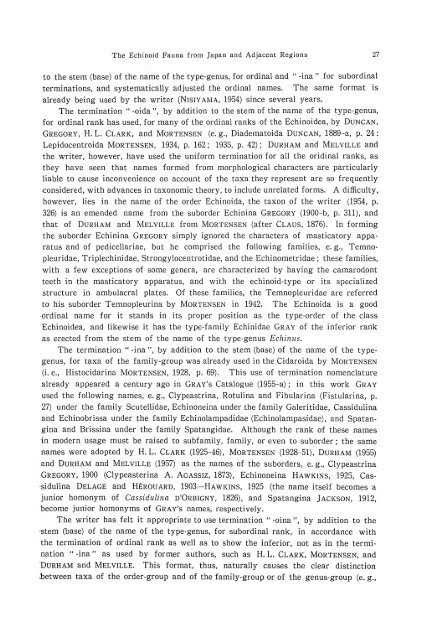the echinoid fauna from japan and adjacent regions part i
the echinoid fauna from japan and adjacent regions part i
the echinoid fauna from japan and adjacent regions part i
You also want an ePaper? Increase the reach of your titles
YUMPU automatically turns print PDFs into web optimized ePapers that Google loves.
The Echinoid Fauna <strong>from</strong> Japan <strong>and</strong> Adjacent Regions 27<br />
to <strong>the</strong> stem (base) of <strong>the</strong> name of <strong>the</strong> type-genus, for ordinal <strong>and</strong>" -ina" for subordinal<br />
terminations, <strong>and</strong> systematically adjusted <strong>the</strong> ordinal names. The same format is<br />
already being used by <strong>the</strong> writer (NISIY AM A, 1954) since several years.<br />
The termination" -oida ", by addition to <strong>the</strong> stem of <strong>the</strong> name of <strong>the</strong> type-genus,<br />
for ordinal rank has used, for many of <strong>the</strong> ordinal ranks of <strong>the</strong> Echinoidea, by DUNCAN,<br />
GREGORY, H. L. CLARK, <strong>and</strong> MORTENSEN (e. g., Diadematoida DUNCAN, 1889-a, p. 24:<br />
Lepidocentroida MORTENSEN, 1934, p. 162; 1935, p. 42); DURHAM <strong>and</strong> MELVILLE <strong>and</strong><br />
<strong>the</strong> writer, however, have used <strong>the</strong> uniform termination for all <strong>the</strong> oridinal ranks, as<br />
<strong>the</strong>y have seen that names formed <strong>from</strong> morphological characters are <strong>part</strong>icularly<br />
liable to cause inconvenience on account of <strong>the</strong> taxa <strong>the</strong>y represent are so frequently<br />
·considered, with advances in taxonomic <strong>the</strong>ory, to include unrelated forms. A difficulty,<br />
however, lies in <strong>the</strong> name of <strong>the</strong> order Echinoida, <strong>the</strong> taxon of <strong>the</strong> writer (1954, p .<br />
.326) is an emended name <strong>from</strong> <strong>the</strong> suborder Echinina GREGORY (1900-b, p. 311), <strong>and</strong><br />
that of DURHAM <strong>and</strong> MELVILLE <strong>from</strong> MORTENSEN (after CLAUS, 1876). In forming<br />
<strong>the</strong> suborder Echinina GREGORY simply ignored <strong>the</strong> characters of masticatory apparatus<br />
<strong>and</strong> of pedicellariae, but he comprised <strong>the</strong> following families, e. g., Temnopleuridae,<br />
Triplechinidae, Strongylocentrotidae, <strong>and</strong> <strong>the</strong> Echinometridae; <strong>the</strong>se families,<br />
with a few exceptions of some genera, are characterized by having <strong>the</strong> camarodont<br />
teeth in <strong>the</strong> masticatory apparatus, <strong>and</strong> with <strong>the</strong> <strong>echinoid</strong>-type or its specialized<br />
structure in ambulacral plates. Of <strong>the</strong>se families, <strong>the</strong> Temnopleuridae are referred<br />
to his suborder Temnopleurina by MORTENSEN in 19L12. The Echinoida is a good<br />
·ordinal name for it st<strong>and</strong>s in its proper position as <strong>the</strong> type-order of <strong>the</strong> class<br />
Echinoidea, <strong>and</strong> likewise it has <strong>the</strong> type-family Echinidae GRAY of <strong>the</strong> inferior rank<br />
.as erected <strong>from</strong> <strong>the</strong> stem of <strong>the</strong> name of <strong>the</strong> type-genus Echinus.<br />
The termination" -ina", by addition to <strong>the</strong> stem (base) of <strong>the</strong> name of <strong>the</strong> typegenus,<br />
for taxa of <strong>the</strong> family-group was already used in <strong>the</strong> Cidaroida by MORTENSEN<br />
(i. e., Histocidarina MORTENSEN, 1928, p. 69). This use of termination nomenclature<br />
already appeared a century ago in GRAY'S Catalogue (1955-a); in this work GRAY<br />
used <strong>the</strong> following names, e. g., Clypeastrina, Rotulina <strong>and</strong> Fibularina (Fistularina, p.<br />
27) under <strong>the</strong> family Scutellidae, Echinoneina under <strong>the</strong> family Galeritidae, Cassidulina<br />
<strong>and</strong> Echinobrissa under <strong>the</strong> family Echinolampadidae (Echinolampasidae), <strong>and</strong> Spatangina<br />
<strong>and</strong> Brissina under <strong>the</strong> family Spatangidae. Although <strong>the</strong> rank of <strong>the</strong>se names<br />
in modern usage must be raised to subfamily, family, or even to suborder; <strong>the</strong> same<br />
names were adopted by H. L. CLARK (1925-46), MORTENSEN (1928-51), DURHAM (1955)<br />
<strong>and</strong> DURHAM <strong>and</strong> MELVILLE (1957) as <strong>the</strong> names of <strong>the</strong> suborders, e. g., Clypeastrina<br />
GREGORY, 1900 (Clypeasterina A. AGASSIZ, 1873), Echinoneina HAWKINS, 1925, Cassidulina<br />
DELAGE <strong>and</strong> HEROUARD, 1903-HAWKINS, 1925 (<strong>the</strong> name itself becomes a<br />
junior homonym of Cassidulina D'ORBIGNY, 1826), <strong>and</strong> Spatangina JACKSON, 1912,<br />
become junior homonyms of GRAY'S names, respectively.<br />
The writer has felt it appropriate to use termination" -oina ", by addition to <strong>the</strong><br />
'stem (base) of <strong>the</strong> name of <strong>the</strong> type-genus, for subordinal rank, in accordance with<br />
<strong>the</strong> termination of ordinal rank as well as to show <strong>the</strong> inferior, not as in <strong>the</strong> termination<br />
"-ina" as used by former authors, such as H. L. CLARK, MORTENSEN, <strong>and</strong><br />
DURHAM <strong>and</strong> MELVILLE. This format, thus, naturally causes <strong>the</strong> clear distinction<br />
:between taxa of <strong>the</strong> order-group <strong>and</strong> of <strong>the</strong> family-group or of <strong>the</strong> genus-group (e. g.,












